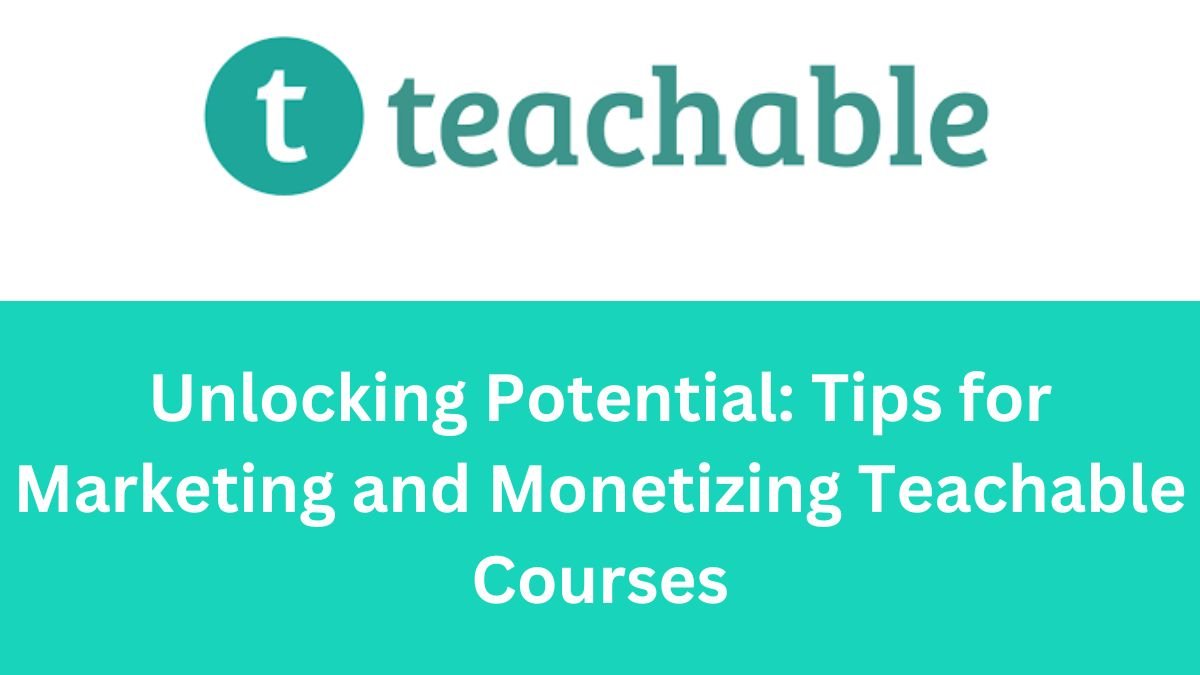In this article, learn about Unlocking Potential: Tips for Marketing and Monetizing Teachable Courses
Table of Contents
ToggleIf you’re in any job, from being a teacher to an entrepreneur, you can increase the amount of money you earn and even make a big difference by making and sharing classes on Teachable; this is all part of learning and understanding, showing that how people get their skills in the area and exchange data has changed because of Teachable courses.
Creating Compelling Course Content
To engage your audience and provide worthwhile learning experiences, there are many essential processes involved in creating engaging course material on Teachable.
Here are some pointers:
- Determine Your Audience:Identify your target audience and the information they are interested in learning. Tailor the content in your course to their needs and their problem.
- Establish Unambiguous Learning Objectives: Clearly state your goals for each lesson or module. Outline what students will learn and achieve at the end of your course.
- Provide Interesting Multimedia material: To make your content engaging and engaging, use the right range of multimedia features, such as infographics, slideshows, movies, and interactive quizzes.
- Employ narrative: To make your content more memorable and relevant, use good narrative strategies. Provide case studies, stories, and real-world examples to highlight important ideas.
- Give Students Useful Advice: We shouldn’t only keep this advice to ourselves. We must discuss about what we’ve been through and all the amazing things we’ve picked up along the way. Next, we look closely at sharing wisdom and helping out, which I’m sure you agree is extremely useful.
- Promote Interaction: It might have been hard to believe but we know that it’s amazing to get young people to work together and feel like they belong in a group. Get them involved in activities where they have to team up, talk in real-time during question and answer times, and discuss on forums to help each other learn and cooperate.
- Provide Resources and Support:We can take as a definite certainty that giving out extra items such as worksheet pages, answer keys, and lists of material to read helps make the course better. Being there to help all the time through live discussion, email, or a forum for support is also very necessary.
- Utilize Iteration and Feedback: You must keep updating your material all the time because what students say and the market can change on you. At its most basic level, simply listen to what the students are saying and use that to make your courses better.
- Prioritize Quality:When discussing these classes, it’s extremely important to pick the best material to use. You should really find some great video and sound stuff, keep your videos short and clear, and double-check any writing to make sure it’s good and has no mistakes. And in the final análisis, one finds that making sure your course things are good is extremely important. We think this advice can really help you see that.
- Promote Your Course: If you want a large number of people to look at your course, start displaying it as soon as it’s prepared. You must take action by posting on social media, sending out messages, and spreading the word with content marketing. One, if they so choose, may decide that to pull in more sign-ups and visits, going for paid ads is the way to go. It’s extremely obvious that if you’re looking to grasp attention for your course, pushing your material in the area right after it’s prepped is key.
These pointers can help you produce engaging Teachable course material that engages students and offers a worthwhile educational experience.
Optimizing for SEO
You can increase the visibility of your Teachable course in search engine results and attract more organic visitors by optimizing it for SEO (search engine optimization).
Here are some pointers for improving the SEO of your Teachable course:
- Keyword Research: Begin by using tools such as Ahrefs, SEMrush, or Google Keyword Planner. By doing this, you’re able to discover those golden keywords many people are searching for but hardly anyone is discussing. Doing this helps you locate things that are inherently, or in substance, similar to treasure hunting – it’s noticeably focused on finding and understanding.
- Maximize Course Title and Description:When naming your course and jotting down what it regards, note to wisely put your major keywords in the description, subtitle, and title. You must ensure the pluses and what you’ll learn in the course come across clearly in both the title and description. Choosing the right words here is the path to discovery and discernment for individuals looking to learn.
- SEO-Friendly URLs: For your course, make sure the web address has important words in it, but—or more suitably, nevertheless—don’t just include a few different numbers or things. The web address should be short, clear, and tell what it regards. You must tailor the web address for your course to make it easy to read and on point.
- Meta Tag Optimization: For enhancing your meta tag approach, start by putting essential keywords in your meta description and meta title tags. Your meta description needs to give a quick summary of what the course is all about, and your meta title has to get attention while featuring your main keyword. Both are inherently, or in substance, similar to making sure people know what your course is about before they click.
- Employ Heading Tags: When you put together material for your class, note to include heading tags like H1, H2, and H3. They’re amazing because they break up your items into parts and point out what’s extremely important. And If you can, try to sprinkle some key phrases in those headings. It might sound a bit hard at first but doing this actually makes it so much clearer which parts are very important and how everything is laid out. We hope this piece may help you understand how to better sort your course materials.
- Optimize photos: To make your course materials’ photos better, add alt text and give them descriptive names. Instead of filling the alt text with many keywords, just add a few that really matter; that way, it helps people find items easier and makes the internet more accessible for everyone. And in what you may think is stark contrast, doing this also boosts your chances of showing up in searches, which is very wonderful.
- Internal Linking: If you’re putting up a course on Teachable, it’s intelligent and informed to link up classes or components that fit together nicely. Makes it simpler for everyone to navigate and not get lost. This isn’t only a win for the people enrolled wanting to hop from one section to the next. It even gives search engines a better clue on what your content’s all about. Then, there’s make it much easier for people searching for information related to your course material. Now, you may be a tad disbelieving that connecting things together could be of significant consequence but it really matters, especially if you’re primarily focused on having people see your online content.
- Make sure your Teachable course is mobile-friendly by checking its design. Because Google uses mobile-friendliness as a ranking criterion, SEO requires a responsive design.
- Page Speed: For this section, let us engage in thinking about how to make Teachable course pages load faster. If you squash down the size of pictures, don’t clutter the location with unnecessary codes, and remember to cache, pages will open up super fast, very fast. This not only makes users happy but also makes your site look better to search engines.
- Superior material: Focus on making good, very useful content that really understands what your audience needs. In what you may think is stark contrast, creating content that’s both fun and informative is more likely to get shared on social media, or linked to that might really help your SEO
- Regular Updates: Keep your teaching material up to date, because keeping it fresh matters. Search engines look for new content, so if you regularly include updates, new courses, or extra material, there is unsurprisingly a potential to boost how you appear in search results.
By incorporating these SEO best practices into your Teachable courses, you can rapidly increase organic traffic, significantly improve search engine performance, and ultimately increase enrollments and conversions.
Leveraging Social Media
Using social media to advertise your Teachable course may help you reach a larger audience and increase enrollments.
Here’s how to utilize Teachable with social media in an efficient manner:
- Produce Powerful Content:Closing out this document, I endeavor to elucidate how to make your items stand out. You must create wonderful and intelligent and informed things about what you’re teaching; think about including helpful posts, videos, pictures, articles, and different kinds of online media; to hook everyone’s attention, give them some small previews or short components of your course work.
- Improve Profiles: First, get a nice photo for your accounts on Instagram, Facebook, LinkedIn, Pinterest, and Twitter. What you must do is make those social media profiles of yours better. And note to make your bio very fun. Also, add some links to your Teachable course. But or more appropriately, nevertheless make sure you’re updating everywhere: Facebook, Instagram, LinkedIn, Pinterest, and Twitter.
- Provide Regular Updates: Make sure you always post updates about your class on social media. You should discuss new phenomena happening talk about when students do well spread the word about interesting things or events coming up and tell people about what’s going on in the business world related to your course. So when it comes to keeping everyone in the loop, there is a profound and deep-seated certainty that spreading the word on social platforms is the way to go. This might be anything from big announcements, specifically how well your students are doing, to the latest events you’ve got planned.
- Engage with Your Audience: Join the conversation with your followers by entering into discussions on social media. You must speak a lot, make sure you’re replying with answers, and simply putting words in the place. If you’re aiming for people to delve deep into conversation about your course, push them to discuss more and share what they’re thinking. Doing all this can sometimes create a group feeling but to be honest, not that often or in a very simple way.
- Employ Visual material: You want to grasp people’s attention on social media? Neat. The way to do it is by putting out eye-catching pictures, videos, and graphics. On social media, things that look good just work better. And when you’re trying to hype up your course, adding some amazing pictures on people’s feeds will keep them interested. It may seem hard to believe but we can take comfort in the fact that a well-placed, vibrant image or a catchy video can actually make people stop scrolling and look at what you’re offering.
- Make Social Media advertising: When you want to tell others about your Teachable course, why not promote it on social media? By targeting your ads, we can easily see that it’s very clear that you’re more likely to reach the exact group of people interested in signing up, such as those who share similar interests, age groups, or online activities. With options such as Facebook Ads, Instagram Ads, LinkedIn Ads, and Twitter Ads, reaching out is really easy. You’re speaking directly to the individuals who are most likely going to be planning on your course.
- Employ Hashtags:To grow your audience and get more attention on social media, both of us know you must include some relevant information in your posts. It is, moreover, apparent to both of us that, if there’s something blowing up related to your course topic, you should surely hold onto those trending ideas and carefully add them into whatever you’re sharing.
- Work Together with Influencers:So, if you work with some professionals who understand many things and can discuss about your course to their own fans, you could get noticed by people who didn’t even know your course existed before. And in universal reality, one mustn’t deny that having these experts discuss your course makes it look extremely legitimate.
- Offer Exclusive material:Offer Exclusive material: Treat your social media fans to exclusive offers, discounts, or material. Make your brand seem exclusive and like a prize for using social media to interact with it.
- Track and Analyze Performance: It might have seemed impossible before but now keeping an eye on how successful you are on social media is something you can do. There are tools in the area that let you check all sorts of interesting stats, such as the number of clicks your posts get, how many people are engaging with them, and who is carefully thinking about what you are sharing. You must keep track of how things are going with what you post online. Look for indicators of success: for example, the money you’re making compared to what you’re spending; the frequency of people clicking on your items; how their behavior changes; and how much they seem to care about your content, generally. By carefully looking at these details, you can change how you manage your social media plan to get better results. And, we might find out that paying attention and making small changes based on what the numbers say can actually make a difference.
You can use social media efficiently to increase publicity for your Teachable course, attract more potential students, and ultimately increase enrollment and income.
Collaborations and Partnerships
Partnerships and collaborations may be effective ways to broaden your audience, reach new ones, and develop your Teachable course company.
The following are some strategies for using alliances and partnerships with Teachable:
- Influencer Collaborations: Work with experts or famous people who have several fans into the same content as your course. All of you can team up to spread the word about your class to their followers. You could do this through sharing profits, doing tasks together, having sponsored content, or making guest appearances. It is moreover apparent to you and I that working with these ideas can really help get your course in the right direction.
- Collaborate:Get together with other teachers or businesses that do the same thing you do. Create programs, packages, or items to do together that both of you will find useful. By sharing what, who, and what you have, you can connect with significantly more people. It may seem hard to believe but we can take comfort in making these kinds of teamwork come true.
- Affiliate Networks: To get people to join your courses, make an affiliate network on Teachable where people might help sell your items in exchange for a share of the money. By giving these partners items they need—such as marketing material, ways to keep track of their progress, and extra benefits—it maximizes their hard work in getting more students; you might feel happy knowing that this system really rewards their effort in an enormous way.
- Material Partnerships: You and other creators who make material that’s the same should work together. You could exchange items such as television episodes, videos, or guest writing posts. It is moreover apparent to you and I, doing this can make you both look more real and let you share followers.
- Corporate Partnerships: Helping big companies, groups, or schools by offering your classes for items such as their worker training, professional growth, or education content is what this is about. One clearly can envision reconfiguring courses or creating special content just for business clients.
- Event Collaborations:Going to industry events, conferences, seminars, or virtual summits makes it easier to work together with the people organizing the events, the speakers, or the sponsors. By doing items such as providing seminars, setting up discussion panels, or even offering exclusive discounts to those attending, one can see unquestionably so that you can really start a good partnership.
- Media Partnerships: If you’re thinking about letting more people know about your course, or sharing content on YouTube channels, newspapers, or online news sites, you have some options. Why not try doing interviews, visiting as a guest, or even teaming up to create content? By doing these things, you’ll manage to spread your message to several different people. A discerning reader, such as yourself, will surely comprehend the wide reaching results of getting your word in the area.
- Community Partnerships: Connect with friends, online groups, and forums that have the audience you’re looking for. Speak to the people there, include some spectacular free items or great bargains, and build friendships that could maybe get more students to sign up for your course. Perhaps of note (at least to certain readers), you must truly participate and show them you are amazing to work with.
- Technology Collaborations:Work together on items such as marketing campaigns that we do as a team, promotions we create together, or combining products, that make the student experience better and your courses significantly better; the undertaking strived to look at teaming up with people who make software, gadgets, or services that work with Teachable.
- Local Partnerships: You may be a little doubtful that this can work but getting together with neighborhood businesses, schools, or other organizations is a intelligent and informed move. They may potentially help throw seminars, workshops, or events related to what your classes are about. A bit unexpectedly, these partnerships can promote your courses through both physical and online spaces in your community.
If you want to really make it big with Teachable, and keep things amazing for a long time, it’s key to see the good material that both you and Teachable can get, know exactly what you want to do, and make new friends. By teaming up, one may immerse themselves in the knowledge that it’s possible to improve your Teachable course business, build up your reputation, and get into new groups.

























